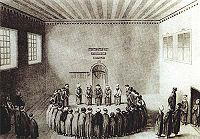
Photo from wikipedia
Objective This study aimed to examine the prevalence and features of migraine and explore the possible migraine triggers in a sample of university nursing students in Hong Kong. Methods A… Click to show full abstract
Objective This study aimed to examine the prevalence and features of migraine and explore the possible migraine triggers in a sample of university nursing students in Hong Kong. Methods A cross-sectional study using self-administered questionnaires was conducted in the Hong Kong Polytechnic University in 2016. The questionnaire included ID Migraine™ for migraine screening and items measuring the frequency, duration, severity, associated symptoms, and trigger factors of migraine. Years 2–5 undergraduate nursing students from the university completed the questionnaires. Binary logistic regression was conducted to examine the migraine-associated factors. Results A total of 702 nursing students, including 168 males and 534 females, were successfully screened. Their mean age was 20.8 ± 1.4 years. The overall prevalence of migraine reached 11.8%. Over half (67.5%) of the students with migraine experienced attacks at least once per month. Each attack had a median duration of 3 h (interquartile range: 1–4 h) and the mean pain intensity score of 6.4 ± 1.6. Students with a family history of migraine (adjusted odds ratio [OR]: 1.89; 95% confidence interval [CI]: 1.10, 3.25; p < 0.05) and poor general health status (Adjusted OR: 3.41, 95% CI: 1.05, 11.09; p < 0.05) were more likely to suffer from migraine than those without. The three most common migraine triggers were the lack of sleep (94.0%), change in sleep schedule (83.1%), and noise (81.9%). Female students were more likely to experience fatigue-triggered migraine than male students (85.9% vs 63.2%, p < 0.05). Conclusion Migraine prevalence was relatively high among undergraduate nursing students in Hong Kong. Sleep problem was the most frequent trigger factor. The students’ awareness of migraine attacks should be increased, and migraine management must be improved by avoiding common trigger factors in this population.
Journal Title: Journal of Pain Research
Year Published: 2022
Link to full text (if available)
Share on Social Media: Sign Up to like & get
recommendations!